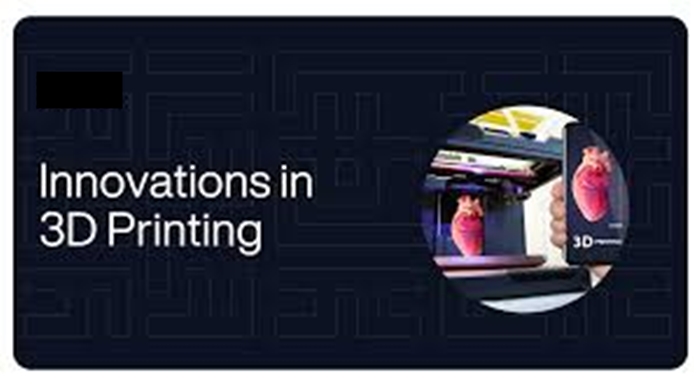In this article, we discussed the 3D printing innovation, the meaning and we also talked about the techniques and innovating layer.
Definition
Three-dimensional (3D) printing is an improved manufacturing process that creates a physical object from a digital design. The process works by laying down thin layers of material in the form of liquid or powdered plastic, metal or cement, and then fusing the layers together.
3D printing, also known as additive manufacturing, is a method of creating a three-dimensional object layer-by-layer using a computer created design. 3D printing is an additive process whereby layers of material are built up to create a 3D part.
Innovation in 3D printing
Innovation is the lifeblood of any technology, and 3D printing is no exclusion. As the technology matures, innovators are always pushing the limits of what is possible, driving advancements in materials, techniques, and applications. These innovations not only improve the efficiency and quality of 3D printing but also unlock new opportunities across various industries.
3D Printing, Innovating Layer by Layer
Personalization and customization
One of the most exciting aspects of 3D printing is its ability to enable mass customization. Whether it’s personalized consumer products or custom medical devices tailored to individual patients, 3D printing allows for unprecedented levels of personalization and customization.
Sustainable practices
As concerns about environmental sustainability grow, 3D printing offers an eco-friendlier alternative to traditional manufacturing methods. By minimizing material waste and reducing energy consumption, 3D printing enables more sustainable production processes.
Medical advancements
In healthcare, 3D printing transforms patient care. It enhances medical technology by creating prosthetics, implantations, surgical tools, and organoids. These advancements improve patient outcomes and cut healthcare costs.
Automation and robotics
Automation plays a crucial role in optimizing the 3D printing workflow. From automated material handling to robotic assembly and post-processing, participating robotics into 3D printing processes enhances efficiency and scalability, paving the way for large-scale adoption across industries.
Innovative Techniques in 3D Printing
Beyond the basic principles of layering, several innovative techniques are pushing the boundaries of what is possible in 3D printing. Let’s discover some of these leading-edge techniques.
Additive manufacturing
Additive manufacturing includes different 3D printing methods like Fused Deposition Modeling (FDM), Stereolithography (SLA), and Selective Laser Sintering (SLS). These methods vary in layering and material deposition, providing distinct benefits for different uses.
Continuous liquid interface production (CLIP)
CLIP is a revolutionary 3D printing technology that uses light and oxygen to rapidly cure liquid resin into solid objects. By harnessing the principles of oxygen inhibition, CLIP enables faster print speeds and smoother surface finishes compared to traditional 3D printing methods.
Bioprinting
Bioprinting, a specialized 3D printing form, deposits biological materials like cells and biomaterials to craft living tissues and organs. This revolutionary technology has vast potential in reformative medicine, tissue engineering, and drug discovery.
Possible Futures of 3D Printing
Construction Industry
Beyond abodes, 3D printing holds immense potential for innovation in the construction industry across a much wider spectrum of applications.
3D printing can be expected, eventually, to construct organization such as bridges, tunnel linings, and dams. Architects and designers can leverage 3D printing to create intricate and customized architectural features, including facades, decoration, and sculptures. The loss of obvious creativity in construction is noted, as cost-saving has defined these features as luxury. 3D printing is likely to free designers from some of these style limits.
Metal 3D Printing
Research is growing in the range of metal mixtures that can be 3D printed. Efforts are being made to optimize existing metal powders for specific applications and to reduce costs and handling difficulties/hazards. The refining of process restrictions and optimization of printing conditions deliver higher precision, improved surface quality, and greater dimensional accuracy. This is partly driven by enhancements and step-changes in laser and electron beam technology, and more obscure advances in powder bed fusion and directed energy deposition techniques. Steady improvements in the speed and productivity of metal 3D printing processes include the development of faster core technologies like multi-laser systems and high-speed powder deposition processes. Less fashionable but equally important are improvements in build chamber design and heat management to reduce print times, improve energy consumption, and increase productivity.
Manufacturing Sector
3D printing will play an increasingly crucial role in advancing sustainability initiatives within the manufacturing sector. More efficient use of materials and support of circular economy principles are expected to result from 3D printing technology penetration into general manufacturing.
Material Innovations
Material innovations in the 3D printing sector are driving significant advances in scope, applicability, and cost, ramping up the capabilities of additive manufacturing technology.
Focused on developing advanced polymer materials with enhanced mechanical properties, chemical resistance, and thermal stability is ongoing and accelerating. More commonly printed improving powder bed methods are allowing a wider variety of outcomes/applications and higher resolutions, approaching molded-part properties. Innovations in metal additive manufacturing materials are resulting in new metal alloys with improved strength, durability, and corrosion resistance. The nature of 3D printing is unlike melt processing, so it allows graded alloys (transitioning between metals through a build) and high-entropy alloys (HEAs, percentage fixtures that cannot form a solution in melt processing) to be used.
Conclusion
This family of technologies is central to the development and refinement of Industry 4.0.
The adoption of the more advanced and more accessible forms of 3D printing continues, growing across diverse fields. As the technology becomes more accessible and multipurpose, its applications will expand into more productization and human-endeavor areas.


